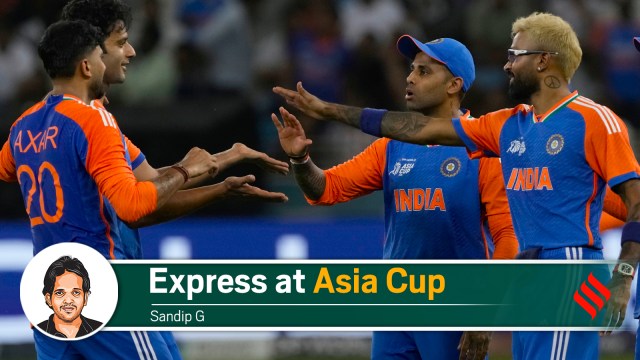ARTICLE AD BOX
 When India played the UAE team in their Asia Cup opener, the excruciating heat of the afternoon and the mildly pleasant breeze of the evening had given away to baking humidity at Dubai International Cricket Stadium in Dubai, United Arab Emirates on Wednesday. (AP Photo)
When India played the UAE team in their Asia Cup opener, the excruciating heat of the afternoon and the mildly pleasant breeze of the evening had given away to baking humidity at Dubai International Cricket Stadium in Dubai, United Arab Emirates on Wednesday. (AP Photo)
Barely twenty minutes into the warm-up before India’s opening game against UAE, at the stroke of twilight, the cameras panned on Gautam Gambhir and his lead-man Jasprit Bumrah locked in an intense chat. He had barely bowled, but already his face was sweat-soaked. As was Gambhir, without him engaging in any activity of physical strain. The excruciating heat of the afternoon and the mildly pleasant breeze of the evening had given away to baking humidity.
As the match unfolded, the support staff lurked around the boundary ropes, especially where the seamers prowled and frequently handed them out ice towels, a practice to cool down their core temperatures, and electrolyte drink supplement. The drinks breaks were longer than usual, and whenever a wicket fell, substitutes rushed to the batsmen to replenish them.
The effects of the heat are in full evidence during the day. Near bus stops, passengers wait impatiently with foldable hand fans, locally called the Japanese fans, or the more modern battery-operated Korean fans that resemble a miniature air fan. Umbrellas–more useful hiding from sun than the rare spells of rain, almost exclusively used in summer and autumn than other seasons–pop up like mushrooms in monsoon. The police have been handing out umbrellas to those that are working outdoors. Migrant workers sweat through their yellow jumpsuits and sprawl on the grassy medians to rest, seeking out valuable slivers of shade.
Some of the malls turn makeshift fitness centres in the morning. Mallathon is the metropolis’s latest buzz, with hundreds hitting the malls in the dawn to work out in the gyms and the climate-controlled walking and running tracks, installed to offer a cooler alternative to outdoor exercises in the morning. On weekends the malls organise sprint fests to encourage running. But the sparklingly tidy streets are near vacant in the afternoons, even though the health warnings have been removed. Sun-seeking tourists have trickled in, but they often hit the beach past midnight.
Respite is round the corner, the locals aver. Two weeks ago, the Suhail star was spotted in the skies over the Middle East. The spotting of the constellation of stars, the locals in Arabian peninsula have believed for centuries, is a celestial clue that the weather patterns are gradually shifting. The temperatures begin to drop in the evening, mild breeze begins to waft in after sunset and an occasional spell of rain could make outdoor chores more pleasant. The plunge in temperature is not steep, but subtle, degree by degree. But another devil kicks in, humidity, which swells in the evenings, before becoming tolerable around midnight, when the city is most vibrant in autumn (the official summer has ended in mid-August).
Both humidity and dew would potentially define games. Humidity would tire out the seamers, the sweaty fingers would make it difficult for spinners to grip the ball. The excessive heat also means that uneven bounce and unpredictable pace could kick in as the tournament progresses and the surface gets tired.
Dew would inevitably disadvantage the team batting first–the effects are well storied. It would be more pronounced in Dubai, the Bedouin-shaped stadium that traps inside it and the surface sweat more. Former UAE coach and former India cricketer Robin Singh told this paper: “Dew will be a huge factor. Since it is the middle of the summer, the evenings will definitely see dew, which means this will be a tournament where the conditions will be perfect to chase. The conditions will definitely be batting friendly, but teams that bat first will have a totally different challenge.”
Story continues below this ad
No captain or player fussed over the conditions, partly because they are used to it. The IPL has been held in Dubai in harsher climes; some of the games started at 4 pm as well. And partly because there is little point. Sri Lanka’s Charith Asalanka said during the captains’ interaction: “We all know it’s really hot out there. It’s important to take care of our fitness. it’s really important to stay fresh and give 100 percent in the first game.” His men landed in Dubai, blazing at 40-plus degrees (feels like temperature even hitting a half-century on Tuesday evening) from Harare, where the highest day-time temperature last week was 23 degrees. In the first two days, before they get acclimated, they would do only light gym work at night.
Though not to the extent of cricketers, the spectators too reeled from the heat, flapping the boundary cards to generate some wind. The draining weather was perhaps the reason the stands, the top-tiers bare, were thinly populated when UAE batted. The conditions, even if they get worse, would not deter them from turning up in hordes for the Sunday mega-show between India and Pakistan.
As September descends and the tournament hits the business end, heat is expected to reduce. Meteorologists believe that days will get cooler after the autumnal equinox on September 23.



.png)
.png)
.png)























 English (US) ·
English (US) ·